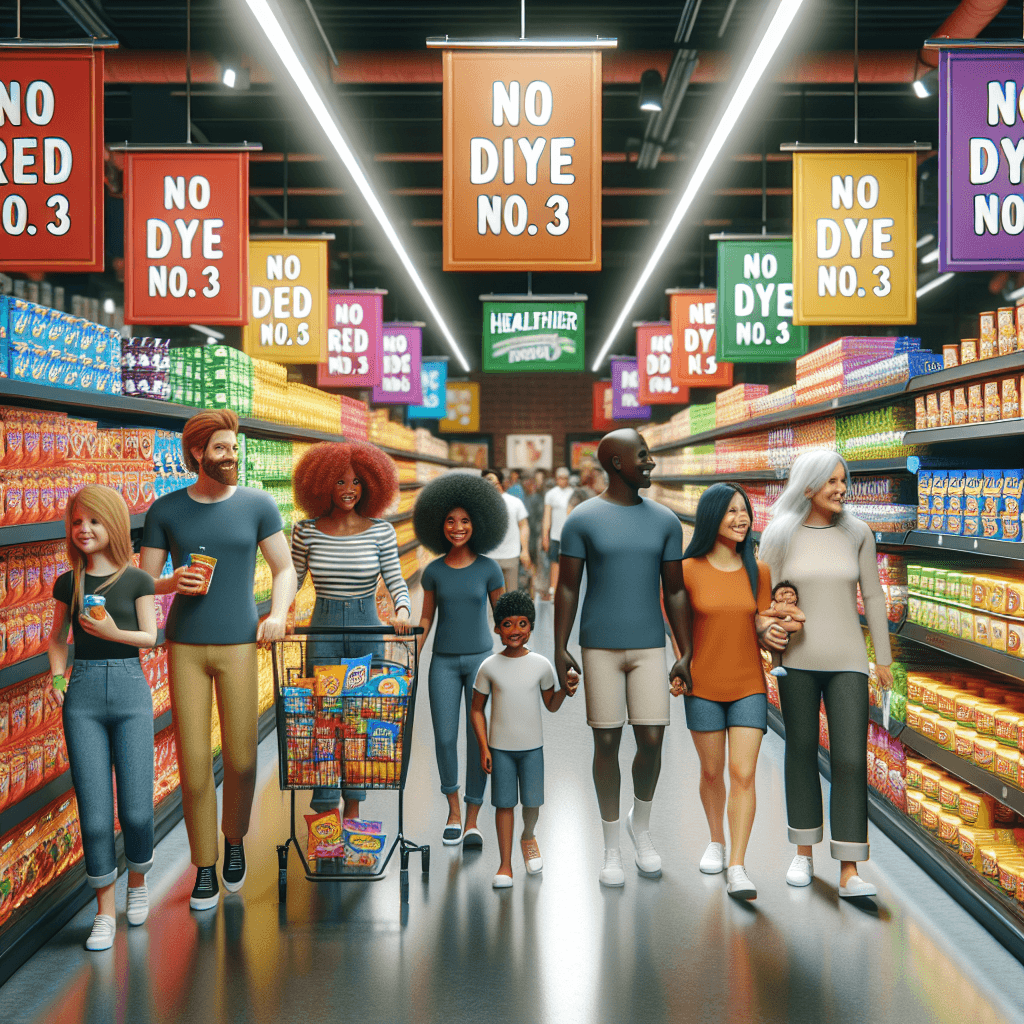Linda Boyle: Goodbye Red Dye No. 3, as Food Giants Begin to Detox Processed Foods
By Must Read Alaska | Updated for 2025 SEO Guidelines
Introduction: The End of Red Dye No. 3 in Processed Foods
In a landmark move for consumer health and food safety, major food manufacturers are finally saying goodbye to Red Dye No. 3, a controversial food additive long criticized for its potential health risks. As reported in Must Read Alaska, this shift is not only a victory for advocates like Linda Boyle but also a critical development for millions of Americans with food sensitivities and dietary preferences. In this comprehensive article, we explore the history of Red Dye No. 3, the reasons behind its removal, the latest research, and how digital tools like Food Scan Genius and Yuka are empowering consumers to make safer food choices.
What is Red Dye No. 3?
Red Dye No. 3, also known as erythrosine, is a synthetic food coloring used in a wide array of processed foods, candies, baked goods, and even some medications. Approved by the FDA in the 1960s, it quickly became ubiquitous in the American food supply. However, concerns about its safety have persisted for decades, especially after animal studies in the 1980s linked it to cancer risks.
According to the FDA’s own records, Red Dye No. 3 was banned from use in cosmetics and topical drugs in 1990, but it remained legal in foods and oral medications. This regulatory inconsistency has been a point of contention among health advocates and consumer groups for years.
Why Are Food Giants Removing Red Dye No. 3?
The recent decision by food giants to detox processed foods and eliminate Red Dye No. 3 is driven by a combination of scientific evidence, consumer demand, and regulatory pressure. As highlighted in the Must Read Alaska article, companies like Mars, General Mills, and Kraft Heinz are responding to mounting evidence and consumer advocacy.
- Health Concerns: Multiple studies have linked Red Dye No. 3 to hyperactivity in children, allergic reactions, and potential carcinogenic effects. A 2023 review in the International Journal of Environmental Research and Public Health reaffirmed the association between synthetic food dyes and behavioral issues in sensitive populations.
- Regulatory Action: In 2023, California passed the “California Food Safety Act,” becoming the first state to ban Red Dye No. 3 in foods, effective January 2027. This legislative move is expected to set a precedent for other states and influence national policy.
- Consumer Demand: Modern consumers are more health-conscious than ever, with a growing segment seeking clean labels, allergen-free, and dye-free products. Social media campaigns and advocacy from figures like Linda Boyle have amplified these demands.
Linda Boyle: A Voice for Food Safety and Sensitivity
Linda Boyle, a prominent advocate for food safety and transparency, has been at the forefront of the movement to eliminate harmful food additives like Red Dye No. 3. Her efforts, featured in the Must Read Alaska article, have inspired parents, educators, and policymakers to push for safer food options, particularly for children and those with food sensitivities.
“This is a huge win for families who have struggled to find safe snacks for their kids,” Boyle said. “We’re finally seeing the food industry listen to the science and prioritize health over profit.”
Recent Research: The Science Behind the Ban
The latest research continues to highlight the risks associated with Red Dye No. 3 and other synthetic food dyes. In the past year, several peer-reviewed studies have provided new insights:
- Behavioral Effects: A 2023 study found that children with ADHD and other sensitivities showed increased hyperactivity and attention issues after consuming foods containing Red Dye No. 3.
- Allergic Reactions: The Food Allergy Research & Education (FARE) organization reported a rise in documented cases of dye-induced allergic reactions, including hives, asthma, and digestive distress.
- Carcinogenic Potential: The California Office of Environmental Health Hazard Assessment lists erythrosine as a chemical known to cause cancer, reinforcing the rationale for its ban.
These findings have been pivotal in persuading both regulators and food manufacturers to take action.
What Does This Mean for People with Food Sensitivities?
For the millions of Americans with food sensitivities, allergies, or specific dietary preferences, the removal of Red Dye No. 3 is a significant step toward safer eating. Synthetic dyes are among the top triggers for adverse reactions in sensitive individuals, especially children. Symptoms can range from mild itching and hives to severe asthma attacks and behavioral changes.
The elimination of Red Dye No. 3 from processed foods means fewer hidden risks in everyday snacks, cereals, candies, and baked goods. However, consumers should remain vigilant, as other synthetic dyes—such as Red 40, Yellow 5, and Blue 1—are still widely used.
How to Identify and Avoid Harmful Food Dyes
Even as food giants begin to detox their products, it’s essential for consumers to know how to read labels and identify potentially harmful additives. Here are some practical tips:
- Check Ingredient Lists: Look for terms like “Red 3,” “Erythrosine,” or “FD&C Red No. 3.”
- Use Digital Tools: Apps like Yuka and Food Scan Genius allow you to scan barcodes and instantly see if a product contains synthetic dyes or other allergens.
- Choose Certified Products: Opt for foods labeled as “dye-free,” “allergen-free,” or “made with natural colors.”
- Advocate for Transparency: Support brands and retailers that prioritize ingredient transparency and consumer safety.
The Role of Food Scan Genius and Yuka in Safer Food Choices
As consumers navigate the evolving food landscape, technology is playing a crucial role in promoting safer dietary choices. Two standout apps—Food Scan Genius and Yuka—are making it easier than ever to identify and avoid harmful additives like Red Dye No. 3.
Food Scan Genius
Food Scan Genius is a cutting-edge app that allows users to scan product barcodes and receive instant feedback on the presence of allergens, artificial dyes, and other additives. The app’s database is continually updated to reflect the latest ingredient changes, including the removal of Red Dye No. 3 by major brands. For people with food sensitivities, Food Scan Genius offers personalized alerts and safe product recommendations.
Yuka
Yuka is another popular app that evaluates food and cosmetic products based on their ingredient safety. By scanning a barcode, users receive a health score and detailed breakdown of additives, including colorants like Red Dye No. 3. Yuka’s transparent scoring system empowers consumers to make informed decisions aligned with their dietary preferences and health needs.
Both apps are especially valuable for parents, individuals with allergies, and anyone seeking to minimize their exposure to synthetic chemicals in food.
What’s Next? The Future of Food Additives and Consumer Advocacy
The removal of Red Dye No. 3 marks a turning point in the food industry’s approach to additives. As more consumers demand clean, safe, and transparent food options, manufacturers are likely to continue reformulating their products and phasing out controversial ingredients.
- Legislative Momentum: Following California’s lead, other states are considering similar bans on synthetic dyes and additives.
- Natural Alternatives: Companies are investing in natural colorants derived from fruits, vegetables, and spices, such as beet juice, turmeric, and annatto.
- Ongoing Research: Scientists are continuing to study the long-term effects of food dyes and advocating for stricter safety standards.
For advocates like Linda Boyle, the fight for safer food is far from over. “We need to keep pushing for transparency and accountability,” Boyle said. “Every family deserves to know what’s in their food.”
How to Stay Informed and Protect Your Family
Staying informed about food additives and industry changes is essential for making safe choices, especially for those with food sensitivities or allergies. Here are some actionable steps:
- Follow Reputable News Sources: Stay updated with trusted outlets like Must Read Alaska, FDA updates, and food safety organizations.
- Use Ingredient-Scanning Apps: Download and regularly use apps like Food Scan Genius and Yuka to check products before purchasing.
- Join Advocacy Groups: Organizations like FARE and the Center for Science in the Public Interest (CSPI) offer resources and support for consumers.
- Educate Your Family: Teach children and family members how to read labels and recognize common additives.
Frequently Asked Questions About Red Dye No. 3
- Is Red Dye No. 3 banned in the United States?
- As of 2024, Red Dye No. 3 is banned in cosmetics and topical drugs but still permitted in foods and oral medications. However, California’s ban will take effect in 2027, and major manufacturers are already phasing it out nationwide.
- What foods commonly contain Red Dye No.





